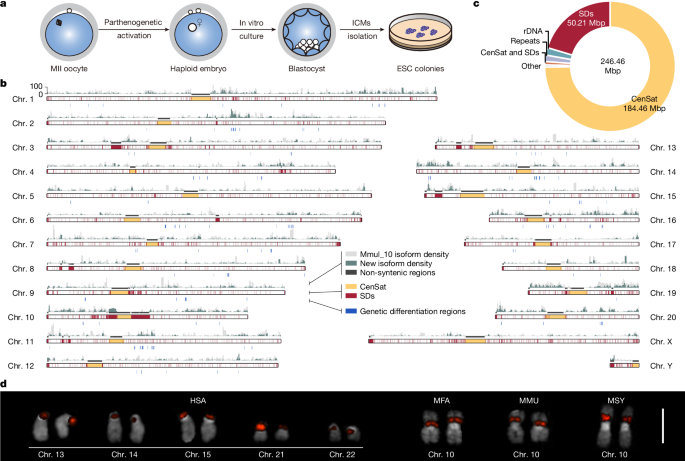Warren, W. C. et al. Sequence diversity analyses of an improved rhesus macaque genome enhance its biomedical utility. Science https://doi.org/10.1126/science.abc6617 (2020).
Rhesus Macaque Genome Sequencing and Analysis Consortium et al. Evolutionary and biomedical insights from the rhesus macaque genome. Science 316, 222–234 (2007).
Rogers, J., Gibbs, R. A., Rogers, J. & Gibbs, R. A. Comparative primate genomics: emerging patterns of genome content and dynamics. Nat. Rev. Genet. 15, 347–359 (2014).
Haus, T. et al. Genome typing of nonhuman primate models: implications for biomedical research. Trends Genet. 30, 482–487 (2014).
Nurk, S. et al. The complete sequence of a human genome. Science 376, 44–53 (2022).
Altemose, N. et al. Complete genomic and epigenetic maps of human centromeres. Science 376, 4178 (2022).
Eichler, E. E. Genetic variation, comparative genomics, and the diagnosis of disease. N. Engl. J. Med. 381, 64–74 (2019).
Seehausen, O. et al. Genomics and the origin of species. Nat. Rev. Genet. 15, 176–192 (2014).
Zoonomia Consortium, A comparative genomics multitool for scientific discovery and conservation. Nature 587, 240–245 (2020).
Mao, Y. & Zhang, G. A complete, telomere-to-telomere human genome sequence presents new opportunities for evolutionary genomics. Nat. Methods https://doi.org/10.1038/s41592-022-01512-4 (2022).
Mao, Y. et al. Structurally divergent and recurrently mutated regions of primate genomes. Cell 187, 1547–1562 (2024).
Kuhlwilm, M., Boeckx, C., Kuhlwilm, M. & Boeckx, C. A catalog of single nucleotide changes distinguishing modern humans from archaic hominins. Sci. Rep. 9, 8463 (2019).
Zeberg, H., Jakobsson, M. & Pääbo, S. The genetic changes that shaped Neandertals, Denisovans, and modern humans. Cell 187, 1047–1058 (2024).
He, Y. et al. Long-read assembly of the Chinese rhesus macaque genome and identification of ape-specific structural variants. Nat. Commun. 10, 4233 (2019).
Cooper, E. B. et al. The Natural History of Model Organisms: the rhesus macaque as a success story of the Anthropocene. eLife https://doi.org/10.7554/eLife.78169 (2022).
Yang, H. et al. Generation of haploid embryonic stem cells from Macaca fascicularis monkey parthenotes. Cell Res. 23, 1187–1200 (2013).
Rautiainen, M. et al. Telomere-to-telomere assembly of diploid chromosomes with Verkko. Nat. Biotechnol. 41, 1474–1482 (2023).
Yang, C. et al. The complete and fully-phased diploid genome of a male Han Chinese. Cell Res. 33, 745–761 (2023).
Jayakumar, V. et al. Chromosomal-scale de novo genome assemblies of cynomolgus macaque and common marmoset. Sci. Data 8, 159 (2021).
Vollger, M. R. et al. Segmental duplications and their variation in a complete human genome. Science 376, 6965 (2022).
Logsdon, G. A. et al. The variation and evolution of complete human centromeres. Nature 629, 136–145 (2024).
Logsdon, G. A. et al. The structure, function and evolution of a complete human chromosome 8. Nature 593, 101–107 (2021).
Shepelev, V. A., Alexandrov, A. A., Yurov, Y. B. & Alexandrov, I. A. The evolutionary origin of man can be traced in the layers of defunct ancestral alpha satellites flanking the active centromeres of human chromosomes. PLoS Genet. 5, 1000641 (2009).
Makova, K. D. et al. The complete sequence and comparative analysis of ape sex chromosomes. Nature 630, 401–411 (2024).
Alexandrov, I., Kazakov, A., Tumeneva, I., Shepelev, V. & Yurov, Y. Alpha-satellite DNA of primates: old and new families. Chromosoma 110, 253–266 (2001).
Papalazarou, V. et al. Phenotypic profiling of solute carriers characterizes serine transport in cancer. Nat. Metab. 5, 2148–2168 (2023).
Salvi, S., Dionisi-Vici, C., Bertini, E., Verardo, M. & Santorelli, F. M. Seven novel mutations in the ORNT1 gene (SLC25A15) in patients with hyperornithinemia, hyperammonemia, and homocitrullinuria syndrome. Human Mutation 18, 460 (2001).
Wu, H., Li, X. & Li, H. Gene fusions and chimeric RNAs, and their implications in cancer. Genes Dis. 6, 385–390 (2019).
Zhang, Y. et al. Readthrough events in plants reveal plasticity of stop codons. Cell Rep. 43, 113723 (2024).
Sahoo, S. et al. Identification and functional characterization of mRNAs that exhibit stop codon readthrough in Arabidopsis thaliana. J. Biol. Chem. 298, 102173 (2022).
Mao, Y.-X. et al. Comparative transcriptome analysis between rhesus macaques (Macaca mulatta) and crab-eating macaques (M. fascicularis). Zool. Res. https://doi.org/10.24272/j.issn.2095-8137.2023.322 (2023).
Chen, S. et al. A genomic mutational constraint map using variation in 76,156 human genomes. Nature 625, 92–100 (2023).
Barile, A. et al. Molecular characterization of pyridoxine 5′-phosphate oxidase and its pathogenic forms associated with neonatal epileptic encephalopathy. Sci. Rep. 10, 13621 (2020).
Hickey, G. et al. Pangenome graph construction from genome alignments with Minigraph-Cactus. Nat. Biotechnol. 42, 663–673 (2023).
Xue, C. et al. The population genomics of rhesus macaques (Macaca mulatta) based on whole-genome sequences. Genome Res. 26, 1651–1662 (2016).
Karl, J. A. et al. Complete sequencing of a cynomolgus macaque major histocompatibility complex haplotype. Genome Res. 33, 448–462 (2023).
Liao, W.-W. et al. A draft human pangenome reference. Nature 617, 312–324 (2023).
Uno, Y., Fujino, H., Kito, G., Kamataki, T. & Nagata, R. CYP2C76, a novel cytochrome P450 in cynomolgus monkey, is a major CYP2C in liver, metabolizing tolbutamide and testosterone. Mol. Pharmacol. 70, 477–486 (2006).
Yoo, D. et al. Complete sequencing of ape genomes. Preprint at bioRxiv https://doi.org/10.1101/2024.07.31.605654 (2024).
Ebler, J. et al. Pangenome-based genome inference allows efficient and accurate genotyping across a wide spectrum of variant classes. Nat. Genet. 54, 518–525 (2022).
Taketomi, Y. et al. Mast cell maturation is driven via a group III phospholipase A2-prostaglandin D2–DP1 receptor paracrine axis. Nat. Immunol. 14, 554–563 (2013).
Wu, J. et al. EHBP1L1, an apicobasal polarity regulator, is critical for nuclear polarization during enucleation of erythroblasts. Blood Adv. 7, 3382–3394 (2023).
Sato, H. et al. Group III secreted phospholipase A2 regulates epididymal sperm maturation and fertility in mice. J. Clin. Invest. 120, 1400–1414 (2010).
Sherman, B. T. et al. DAVID: a web server for functional enrichment analysis and functional annotation of gene lists (2021 update). Nucleic Acids Res. 50, 216 (2022).
Darbellay, F. et al. The constrained architecture of mammalian Hox gene clusters. Proc. Natl Acad. Sci. USA 116, 13424–13433 (2019).
Dollé, P. et al. Disruption of the Hoxd-13 gene induces localized heterochrony leading to mice with neotenic limbs. Cell 75, 431–441 (1993).
Kingsley, E. P. et al. Adaptive tail-length evolution in deer mice is associated with differential Hoxd13 expression in early development. Nat. Ecol. Evol. 8, 791–805 (2024).
Willard, H. F. Chromosome-specific organization of human alpha satellite DNA. Am. J. Hum. Genet. 37, 524–532 (1985).
O’Keefe, C. L. & Matera, A. G. Alpha satellite DNA variant-specific oligoprobes differing by a single base can distinguish chromosome 15 homologs. Genome Res. https://doi.org/10.1101/gr.10.9.1342 (2000).
Maggiolini, F. et al. Single-cell strand sequencing of a macaque genome reveals multiple nested inversions and breakpoint reuse during primate evolution. Genome Res. 30, 1680–1693 (2020).
Ventura, M. et al. Evolutionary formation of new centromeres in macaque. Science 316, 243–246 (2007).
Rocchi, M., Archidiacono, N., Schempp, W., Capozzi, O. & Stanyon, R. Centromere repositioning in mammals. Heredity 108, 59–67 (2011).
Ma, S. et al. Molecular and cellular evolution of the primate dorsolateral prefrontal cortex. Science https://doi.org/10.1126/science.abo7257 (2022).
Wu, J. et al. Integrating spatial and single-nucleus transcriptomic data elucidates microglial-specific responses in female cynomolgus macaques with depressive-like behaviors. Nat. Neurosci. 26, 1352–1364 (2023).
Blakely, R. D., Robinson, M. B., Thompson, R. C. & Coyle, J. T. Hydrolysis of the brain dipeptide N‐acetyl‐l‐aspartyl‐l‐glutamate: subcellular and regional distribution, ontogeny, and the effect of lesions on N‐acetylated‐α‐linked acidic dipeptidase activity. J. Neurochem. 50, 1200–1209 (1988).
Rahn, K. A. et al. Inhibition of glutamate varboxypeptidase II (GCPII) activity as a treatment for cognitive impairment in multiple sclerosis. Proc. Natl Acad. Sci. USA 109, 20101–20106 (2012).
The ENCODE Project Consortium. An integrated encyclopedia of DNA elements in the human genome. Nature https://doi.org/10.1038/nature11247 (2012).
Florio, M. et al. Human-specific gene ARHGAP11B promotes basal progenitor amplification and neocortex expansion. Science 347, 1465–1470 (2015).
Ma, K., Yang, X. & Mao, Y. Advancing evolutionary medicine with complete primate genomes and advanced biotechnologies. Trends Genet. https://doi.org/10.1016/j.tig.2024.11.001 (2024).
King, M.-C. & Wilson, A. C. Evolution at two levels in humans and chimpanzees. Science 188, 107–116 (1975).
Cheng, H. et al. Haplotype-resolved assembly of diploid genomes without parental data. Nat. Biotechnol. https://doi.org/10.1038/s41587-022-01261-x (2022).
Cheng, H. et al. Haplotype-resolved de novo assembly using phased assembly graphs with hifiasm. Nat. Methods https://doi.org/10.1038/s41592-020-01056-5 (2021).
Pardo-Palacios, F. J. et al. SQANTI3: curation of long-read transcriptomes for accurate identification of known and novel isoforms. Nat. Methods https://doi.org/10.1038/s41592-024-02229-2 (2024).
Numanagić, I. et al. Fast characterization of segmental duplications in genome assemblies. Bioinformatics https://doi.org/10.1093/bioinformatics/bty586 (2018).
Jumper, J. et al. Highly accurate protein structure prediction with AlphaFold. Nature https://doi.org/10.1038/s41586-021-03819-2 (2021).
Garrison, E., Kronenberg, Z. N., Dawson, E. T., Pedersen, B. S. & Prins, P. A spectrum of free software tools for processing the VCF variant call format: vcflib, bio-vcf, cyvcf2, hts-nim and slivar. PLOS Comput. Biol. https://doi.org/10.1371/journal.pcbi.1009123 (2022).
Yun, T. et al. Accurate, scalable cohort variant calls using DeepVariant and GLnexus. Bioinformatics https://doi.org/10.1093/bioinformatics/btaa1081 (2021).
Poplin, R. et al. A universal SNP and small-indel variant caller using deep neural networks. Nat. Biotechnol. https://doi.org/10.1038/nbt.4235 (2018).
Wenger, A. M. et al. Accurate circular consensus long-read sequencing improves variant detection and assembly of a human genome. Nat. Biotechnol. https://doi.org/10.1038/s41587-019-0217-9 (2019).
Ebert, P. et al. Haplotype-resolved diverse human genomes and integrated analysis of structural variation. Science https://doi.org/10.1126/science.abf7117 (2021).
Heller, D. & Vingron, M. SVIM: structural variant identification using mapped long reads. Bioinformatics https://doi.org/10.1093/bioinformatics/btz041 (2019).
Heller, D. & Vingron, M. SVIM-asm: structural variant detection from haploid and diploid genome assemblies. Bioinformatics https://doi.org/10.1093/bioinformatics/btaa1034 (2021).
Vollger, M. R. & Harvey, W. T. mrvollger/fastCN-smk: v0.2. Zenodo https://doi.org/10.5281/zenodo.8136270 (2023).
Love, M. I. et al. Moderated estimation of fold change and dispersion for RNA-seq data with DESeq2. Genome Biol. https://doi.org/10.1186/s13059-014-0550-8 (2014).
Ritchie, M. E. et al. limma powers differential expression analyses for RNA-sequencing and microarray studies. Nucleic Acids Res. https://doi.org/10.1093/nar/gkv007 (2015).
Zheng, G. X. Y. et al. Massively parallel digital transcriptional profiling of single cells. Nat. Commun. https://doi.org/10.1038/ncomms14049 (2017).
Hao, Y. et al. Integrated analysis of multimodal single-cell data. Cell https://doi.org/10.1016/j.cell.2021.04.048 (2021).
Hao, Y. et al. Dictionary learning for integrative, multimodal and scalable single-cell analysis. Nat. Biotechnol. https://doi.org/10.1038/s41587-023-01767-y (2023).
Nei, M., Li, W. H., Nei, M. & Li, W. H. Mathematical model for studying genetic variation in terms of restriction endonucleases. Proc. Natl Acad. Sci. USA https://doi.org/10.1073/pnas.76.10.5269 (1979).
Bhatia, G., Patterson, N., Sankararaman, S. & Price, A. L. Estimating and interpreting FST: the impact of rare variants. Genome Res. https://doi.org/10.1101/gr.154831.113 (2013).
Sabeti, P. C. et al. Genome-wide detection and characterization of positive selection in human populations. Nature https://doi.org/10.1038/nature06250 (2007).
Liu, Z. et al. Population genomics of wild Chinese rhesus macaques reveals a dynamic demographic history and local adaptation, with implications for biomedical research. Gigascience https://doi.org/10.1093/gigascience/giy106 (2018).
Ding, W. et al. Adaptive functions of structural variants in human brain development. Sci. Adv. https://doi.org/10.1126/sciadv.adl4600 (2024).
Zemke, N. R. et al. Conserved and divergent gene regulatory programs of the mammalian neocortex. Nature https://doi.org/10.1038/s41586-023-06819-6 (2023).
Ning, C. et al. Epigenomic landscapes during prefrontal cortex development and aging in rhesus. Natl Sci. Rev. https://doi.org/10.1093/nsr/nwae213 (2024).
Zhang, S. Integrated analysis of the complete sequence of a macaque genome (code archive). Zenodo https://doi.org/10.5281/zenodo.14220081 (2024).


